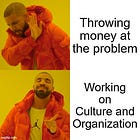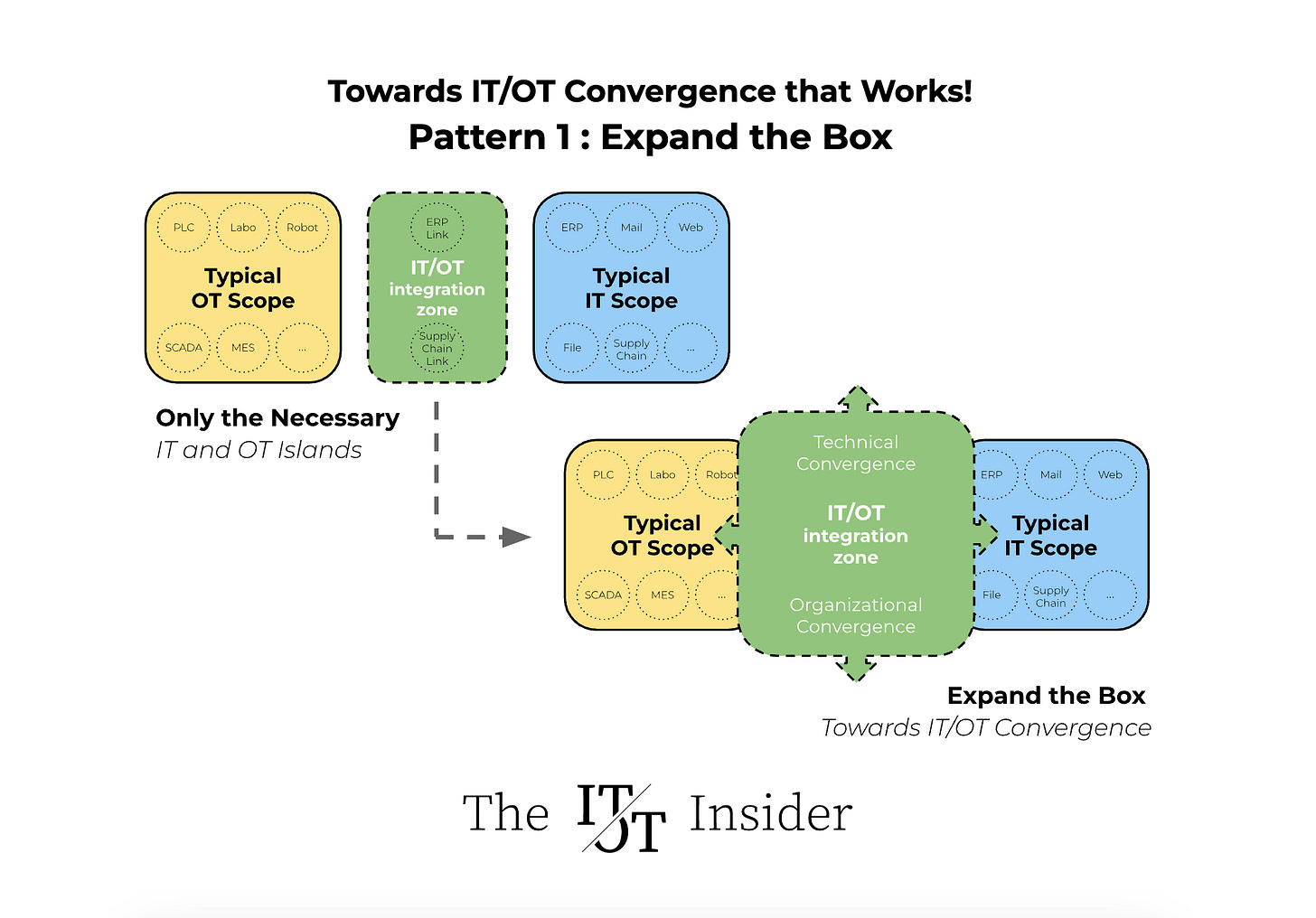IT/OT Cooperation Models: A Field Guide (Part 2)
Part 2 of our Patterns and Antipatterns on IT/OT Cooperation. Up this week: What you should do.
Our IT/OT Cooperation Models article doesn't help you when you want to move to a better cooperation model. We can’t give you the recipe for your organization, but we can help you with some (anti-)patterns to move away from a siloed organization to a more responsive one.
In Part 1 we introduced 2 important antipatterns (things you should not do):
Antipattern 1: IT/OT Convergence as a top-down decision by management
Antipattern 2: IT/OT Convergence is about making OT become more like IT (or vice versa)
Up this week: What you should do.
Pattern 1: Real IT/OT Convergence is Expanding the Common Ground, both technically and organizationally.
Food for thought:
Convergence is about expanding the common ground. That common ground encompasses both technical and organizational aspects. As a consequence of that expansion, collaboration becomes easier allowing the organization to effectively solve business problems.
What is that common ground we are expanding here?
It is technical convergence: This is about existing and future technologies that make it easier to switch between both worlds. Take your pick:
Bringing in the power of cloud technologies to OT environments.
Leveraging the strengths of OT in how it handles time series data at scale.
Develop developer friendly data tooling so we all expose our data in the right ways to the right consumers.
Apply advanced IT security practices in OT
Integrating OT and IT data models
…
The possibilities are growing faster than you can absorb them, so choose what’s delivering the most value to you today and don’t waste your time with a 5 year roadmap.
NEW! We just launched our ITOT.Academy. Learn everything there is to know about the Cooperation Models in our Live Online Academy
It is organizational convergence: This isn’t about drawing a new organization on paper, but rather to ensure that OT people at least understand the ways of working in IT and vice versa (IT people also need a better understanding of OT). This ultimately leads to increased innovation and collaboration on both sides.
You may want to instantly start pondering how a new organizational model can help you reach these objectives. Don’t fall for that trap. Instead, put your energy in expanding the collaboration zone between IT and OT.
What’s in the green box?
The green box is nothing more than what we have in common. At the start both seem to work with different technologies and think in different ways: DCS vs ERP, PLC vs cloud server, agile vs detailed requirements, CI/CD vs FAT…
The moment you need to work together however that split is costing you a lot of money. Organizations that manage to increase what’s in common will be rewarded with more innovative, more effective and faster deployment of solutions to real problems in production.
The way to increase the size of that box isn't some star project manager or leader with all the answers coming from the latest fad. You’ll need to facilitate cooperation the hard way and remove obstacles while respecting the differences.
Pattern 2: Forget Convergence, start with Cooperation
Food for thought (bis):
Improving cooperation between IT and OT is always the best next step.
As we said, convergence means expanding the box from a technical and organizational perspective. The best way we know to achieve both is to improve cooperation, over and over again.
Technical integration is not completely in your hands. The current state of technology has its limits and manufacturing companies won’t be the ones solving those problems. But by exposing people to both worlds you’ll be a step ahead of competition when it comes to trying out new technologies in an effective way.
Organizational integration:
If you’re looking for inspiration on how to start, two cooperation models stand out:
A small group of people will be sent out to facilitate cooperation in the other organization (your “liaisons”). Establishing trust and a shared understanding is a logical initial stride towards cooperation.
It does not create a new silo and as such isn’t creating more distance over time. However, this is no replacement for a common approach to digitalization and doesn’t scale.
Temporary central project team
The goal of this team is to explore what collaboration means within a limited amount of time (1-2 years) and be staffed accordingly. This pattern will only work if there is a desire from both organizations to cooperate in the future, but they’re just not certain what that looks like.
It’s super important to highlight some key words in the above sentences:
(1) Limited amount of time: We really (really, really) do not want to end up in a semi-final situation with 3 silos.
(2) Staffed accordingly: A sufficient number of dedicated and motivated individuals from both the OT and IT sides come together to form a temporary project team, collaborating on a series of carefully selected initial projects.
(3) Desire to evolve: If both organizations didn’t change after this time the entire effort was wasted. This is a change program. At the end there should be a clear evolution compared to the beginning.

Don’t focus on the future organizational model yet. It should be to be on speaking terms with each other and understanding each other’s needs. From that basis you’ll explore how to expand the box.
Further Reading
Make sure to subscribe to receive the final part of this series on IT/OT Convergence.
In Part 3 we will cover:
Ways to blur the lines and expand the green collaboration box
Introduce possible future organizational models
Previous articles you might want to review on Technical Convergence:
Previous articles you might want to review on Organizational Convergence:
A personal note 🙂
Welcome to our first post of 2024! We want to extend a sincere thank you for being part of our IT/OT Insider Community. Your engagement and interest make our shared exploration of these topics truly valuable.
If you've found our content insightful, consider sharing it with your network.
Subscribe if you'd like to stay ahead of the IT/OT game with our weekly insights (no spam!).
In 2024 we will be publishing a series of interviews with your peers on their experiences with IT/OT Convergence, if you have a story to share, reach out to us.
Thank you for being a part of our community. Happy 2024 🎉 Enjoy this new article!
Willem & David
Shareable image:
The images in this post are based on work at devopstopologies.com - licensed under CC BY-SA.










